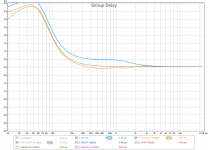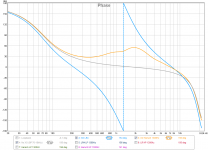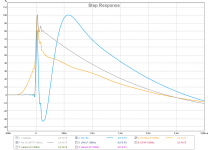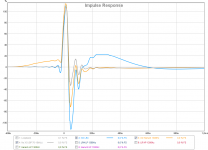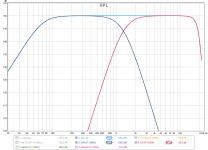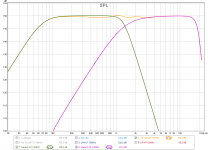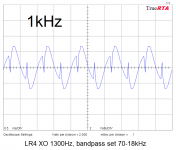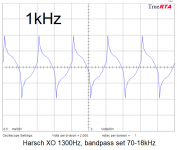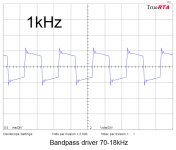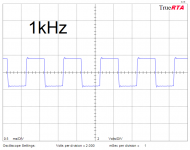Thanks for trying this out - you did a fantastic job of matching it to the textbook curves and the final SR shows it. You might try flipping it around as Quip suggested with BW4 on tweeter and Bessel on woofer. Or maybe add an additional PEQ at somewhere below XO to help attenuate the tweeter some more. Great results though. How does it sound?
Wonder if Mr.Harsch himself could comment on the effectiveness of reversing his proposed slopes. Apparently he has just started a fledgling in-ear monitor business (details here). If his IEMs use the Harsch crossover, that'd be very cool indeed.
Would be nice to see off-axis response too, but your results are hugely promising, PLB.
My first try of Harsch (comp to LR4)
I've made a test speaker to see if I like compression drivers (well one at least) and to test an idea of how to control vertical directivity. I looks like this:
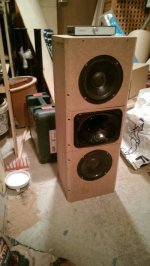
It's a Beyma CD10Fe on Eighteensound XT120 between two woofers (5") that were salvaged from a small floor stander from Audio Pro. Dimensions of baffle are 25x69 cm (10x27"). (The reason I'm so detailed in this post is because I've never really looked at crossovers before, so please tell me if I'm doing something strange.)
I first used a little PEQ (minidsp, only subractive) to flatten the curves:
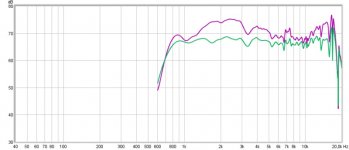
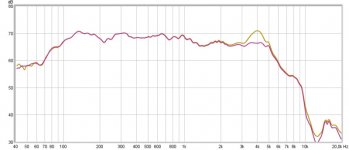
This is how I first set up the xover (LR4 1300 Hz):

Looks quite nice IMHO.
With phase:
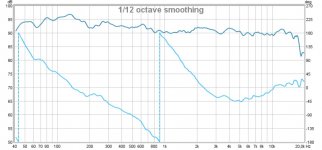
Distortion:
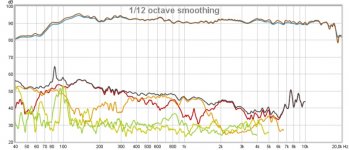
How about step response?
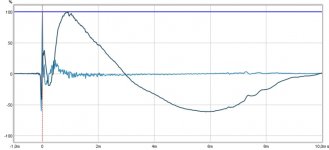
Oh. Not very good.
Lets test the Harsch method (1300 Hz as well):
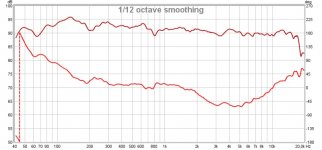
Much better phase.
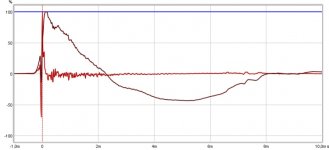
Much better step. Impulse is still first -70 % before +100. Fixable? I chose a reasonable delay from a physical point of view (deep waveguide) and then added the delay from the Harsch method. After that I tweaked (increased slightly) to get a cleaner step response.
I only have one speaker done (only bought one CD) and the amplifier is way too noisy (or the sensitivity of the CD is too high) for me to give any comments on sound quality.
EDIT: Measurements done outdoor, ~1.5 m above ground, 2 m distance. Only CD measurement windowed, the rest is using 1/12 octave smoothing.
/Anton
I've made a test speaker to see if I like compression drivers (well one at least) and to test an idea of how to control vertical directivity. I looks like this:

It's a Beyma CD10Fe on Eighteensound XT120 between two woofers (5") that were salvaged from a small floor stander from Audio Pro. Dimensions of baffle are 25x69 cm (10x27"). (The reason I'm so detailed in this post is because I've never really looked at crossovers before, so please tell me if I'm doing something strange.)
I first used a little PEQ (minidsp, only subractive) to flatten the curves:


This is how I first set up the xover (LR4 1300 Hz):

Looks quite nice IMHO.
With phase:

Distortion:

How about step response?

Oh. Not very good.
Lets test the Harsch method (1300 Hz as well):

Much better phase.

Much better step. Impulse is still first -70 % before +100. Fixable? I chose a reasonable delay from a physical point of view (deep waveguide) and then added the delay from the Harsch method. After that I tweaked (increased slightly) to get a cleaner step response.
I only have one speaker done (only bought one CD) and the amplifier is way too noisy (or the sensitivity of the CD is too high) for me to give any comments on sound quality.
EDIT: Measurements done outdoor, ~1.5 m above ground, 2 m distance. Only CD measurement windowed, the rest is using 1/12 octave smoothing.
/Anton
Last edited:
Great work Onni! I have marveled at your 3d FEA sims and 3d waveguide printing and now you also make speakers for real. Test boxes are exactly the way to go and glad you are trying out xo with minidsp route. CD's are indeed noisy because they are 108dB sensitive. So a clean quiet source is needed to get rid of hiss. It's not the minidsp but typically the computer sound card. Switching to a good external DAC helps.
Agree with Byrtt that you may have polarity of CD reversed. Flip that and you will need to readjust delay.
Looks really promising so far. Listen to some live recorded guitars or drums and tell us if you hear a difference.
Thanks for sharing.
Agree with Byrtt that you may have polarity of CD reversed. Flip that and you will need to readjust delay.
Looks really promising so far. Listen to some live recorded guitars or drums and tell us if you hear a difference.
Thanks for sharing.
Flat phase before crossover?
You are correct in your assumption that there was something wrong in the wiring, either the amplifier (TPA3116) has incorrect markings, or I've misinterpreted the markings on the woofer. I can't seem to get it working though, is it because the phase needs to be flat before adding the crossover?
Here is how they measure before adding crossover (wired so I get correct direction on step response):
Woofer:
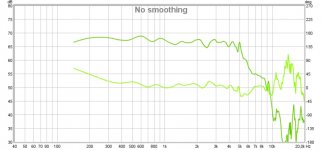
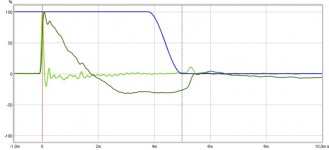
Tweeter:
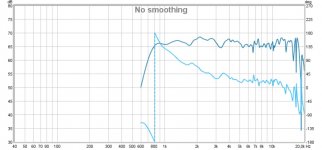
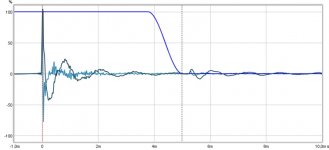
Together:
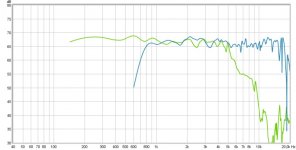
And this is what happens if I follow the method:
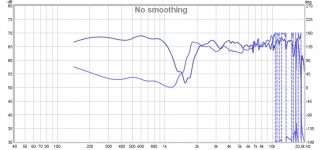
That is, setting 0.3 ms delay in the woofer for physical time alignment (is there a way of getting this from the measurements?) and setting 0.38 ms delay on the tweeter (0.5/1300 Hz). Impulse/step response:
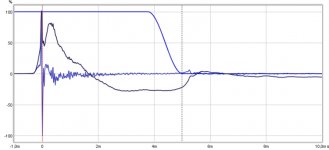
If I then invert the tweeter I get this:
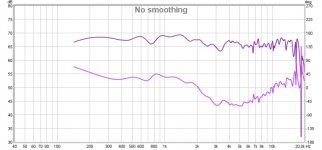
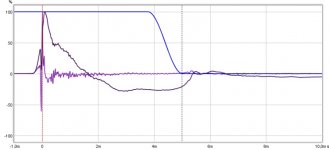
Is it all due to the phase slope of the tweeter? If so: can I add something (all pass filter) to correct this in the minidsp?
Note: all measurements at 1 m distance, 1.3 m height and windowed (2 ms before, 5 ms after). Directly in front of tweeter.
/Anton
You are correct in your assumption that there was something wrong in the wiring, either the amplifier (TPA3116) has incorrect markings, or I've misinterpreted the markings on the woofer. I can't seem to get it working though, is it because the phase needs to be flat before adding the crossover?
Here is how they measure before adding crossover (wired so I get correct direction on step response):
Woofer:


Tweeter:


Together:

And this is what happens if I follow the method:

That is, setting 0.3 ms delay in the woofer for physical time alignment (is there a way of getting this from the measurements?) and setting 0.38 ms delay on the tweeter (0.5/1300 Hz). Impulse/step response:

If I then invert the tweeter I get this:


Is it all due to the phase slope of the tweeter? If so: can I add something (all pass filter) to correct this in the minidsp?
Note: all measurements at 1 m distance, 1.3 m height and windowed (2 ms before, 5 ms after). Directly in front of tweeter.
/Anton
Use the "overlay" feature in REW and plot the step response for woofer and tweeter with the phase such that both go up. The overlay will show the delay between the tweeter pulse and woofer rising edge. Adjust delay to move these together. A delay shifted more than 180deg will require a phase flip on tweeter. That means your delay of is off by more than a half cycle at the XO frequency.
You are close. You also can tell when you do it right in that combined response will fall a little below the plain woofer response.
You are close. You also can tell when you do it right in that combined response will fall a little below the plain woofer response.
onni,
Hope below plots can help as target curves, these are made in JRivers digital DSP engine, soundcard then hardwired between analog I/O and REW can be made listening inside loop because of a genius JRiver virtual soundcard addition to sound system. System bandwidth are set with a BW2 HP at 70Hz and BW2 18kHz LP but the LP get steeper because of REW and soundcard bandwidth limit of 24kHz cut off. So they are real electric measured filters that you can use as ideal target curves your system should replicate in acoustic domain. Attach two frd files you can import to REW as visual target slope in "All SPL" or in "Overlays" window, these are normalized to 67dB at moment but just offset them to other SPL leves in REW is no problem. HP these plots is set the textbook 0,38mS (1/1300x0,5) delay, add or subtract to this setting to calibrate the physical acoustic offset at 1300Hz you probably have.
FR plots are 1300Hz Harsch and LR4 XO, IR/SR/Phase/GD are Harsch/LR4/Bandpass 70-18kHz with no XO.
Hope below plots can help as target curves, these are made in JRivers digital DSP engine, soundcard then hardwired between analog I/O and REW can be made listening inside loop because of a genius JRiver virtual soundcard addition to sound system. System bandwidth are set with a BW2 HP at 70Hz and BW2 18kHz LP but the LP get steeper because of REW and soundcard bandwidth limit of 24kHz cut off. So they are real electric measured filters that you can use as ideal target curves your system should replicate in acoustic domain. Attach two frd files you can import to REW as visual target slope in "All SPL" or in "Overlays" window, these are normalized to 67dB at moment but just offset them to other SPL leves in REW is no problem. HP these plots is set the textbook 0,38mS (1/1300x0,5) delay, add or subtract to this setting to calibrate the physical acoustic offset at 1300Hz you probably have.
FR plots are 1300Hz Harsch and LR4 XO, IR/SR/Phase/GD are Harsch/LR4/Bandpass 70-18kHz with no XO.
Attachments
Last edited:
Now I get something that seems more reasonable, problem was to get a frequency response that is even at the same time as a good impulse response. The phase was shifting too much for the CD when using a 1300 Hz XO.
Here's a 1700 XO:
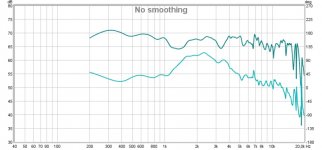
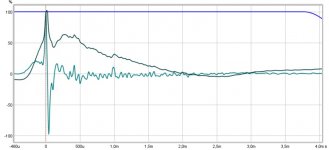
And a 2200 XO:
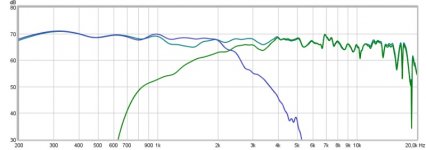
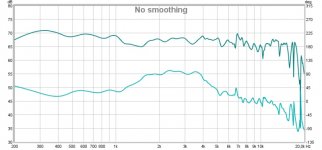
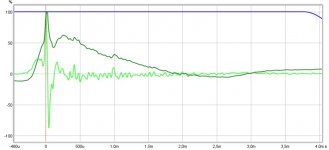
Horisontal polars (0, 30, 60 deg) for 2200 XO:
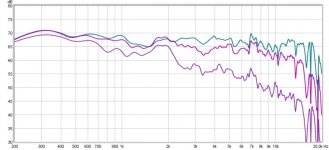
I feel like it's mainly the crappy impulse response of the CD that messes stuff up:
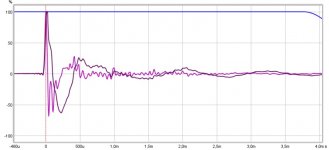
Raw.
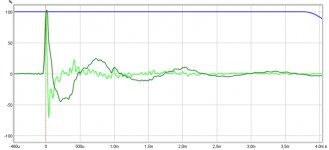
Without HP. With PEQ.
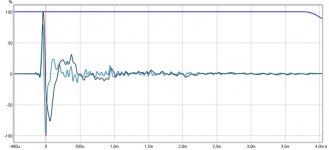
With HP (1700) and PEQ.
/Anton
Here's a 1700 XO:


And a 2200 XO:



Horisontal polars (0, 30, 60 deg) for 2200 XO:

I feel like it's mainly the crappy impulse response of the CD that messes stuff up:

Raw.

Without HP. With PEQ.

With HP (1700) and PEQ.
/Anton
That looks good. Glad you got it figured out. Check the throat transition from CD to waveguide. Make sure it is smooth - no overhanging lip or rough edges. That can cause the bumpy FR on the CD.
The tell tale sign you got it right is the combined dips a little below woofer only:

Nice work
It should sound very good on live recordings with percussion, drums, guitar, etc.
A noticeable difference to my ears. Listen to something like this:
https://www.youtube.com/watch?v=pb5NEC_2Svk
Try with Harsch vs plain LR2
The tell tale sign you got it right is the combined dips a little below woofer only:

Nice work
It should sound very good on live recordings with percussion, drums, guitar, etc.
A noticeable difference to my ears. Listen to something like this:
https://www.youtube.com/watch?v=pb5NEC_2Svk
Try with Harsch vs plain LR2
Hi Xr,
I like a lot the data of the 5" to try a midle high efficienty speaker without horn in the mids ! Like a lot what you have given elswhere as an equivalent swap for this 5" : http://www.parts-express.com/pedocs...9111X1517312Xe34a3b7c82be4c12027f328e6b1b87e6
What do you think of this tweeter to swap also the PRV stuffs in the highs : SB Acoustics :: Satori TW29RN <font color="#FFFF00">NEW! </font> : 96 DB, quite a good match with the mid ?
Your design with a little work to try an open back damping frame à la MPL (Gerhardt Joachim thread) to go nearer from a cardioid than an OB to putt it nearer from the front wall (than an OB) could be a way to go for my own needs (I can't putt an OB at 2 or 3 meters of the front wall in my living room...).
Nice design that you made
I like a lot the data of the 5" to try a midle high efficienty speaker without horn in the mids ! Like a lot what you have given elswhere as an equivalent swap for this 5" : http://www.parts-express.com/pedocs...9111X1517312Xe34a3b7c82be4c12027f328e6b1b87e6
What do you think of this tweeter to swap also the PRV stuffs in the highs : SB Acoustics :: Satori TW29RN <font color="#FFFF00">NEW! </font> : 96 DB, quite a good match with the mid ?
Your design with a little work to try an open back damping frame à la MPL (Gerhardt Joachim thread) to go nearer from a cardioid than an OB to putt it nearer from the front wall (than an OB) could be a way to go for my own needs (I can't putt an OB at 2 or 3 meters of the front wall in my living room...).
Nice design that you made
Last edited:
Hi Xr,
I like a lot the data of the 5" to try a midle high efficienty speaker without horn in the mids ! Like a lot what you have given elswhere as an equivalent swap for this 5" : http://www.parts-express.com/pedocs...9111X1517312Xe34a3b7c82be4c12027f328e6b1b87e6
What do you think of this tweeter to swap also the PRV stuffs in the highs : SB Acoustics :: Satori TW29RN <font color="#FFFF00">NEW! </font> : 96 DB, quite a good match with the mid ?
Your design with a little work to try an open back damping frame à la MPL (Gerhardt Joachim thread) to go nearer from a cardioid than an OB to putt it nearer from the front wall (than an OB) could be a way to go for my own needs (I can't putt an OB at 2 or 3 meters of the front wall in my living room...).
Nice design that you made
That Satori tweeter looks great - should be a very nice match, maybe XO at 6kHz to keep the nice full range coherency? You may want a 5in dia waveguide to match polar directivity or set XO freq accordingly.
Open back damping should work well, why not just go aperiodic (heavily stuffed short) TL?
45° polar match between the two drivers you mean ? Enough ? Or is it the center to center between the two units which make it hard to do at those high XOs (>6K Hz) ?
I was thinking about a HP LR1 around 7K hz (we have more than 3 octaves above the tweeter FS )
)
below your 5" I was thinking (but waiting the return of a member in the TPH-140 thread) to this http://www.beyma.com/getpdf.php?pid=12P80Nd/V2 of course with EQ but the incredible BL/Mms, Qts and Eq are incredible for a mid-bass instead a vented bass: 80-100 hz to 800 hz e.g. but without any load (or max a damped U-Frame, although here I surmise a rear damping should be hard to work ! Here OB or damped back U-Frame Or à la Aino Gradient tilted towards trhe ceilling?
Have to look at also about what Bob talked about the ribon Fountek tweeter... In my mind little plastic horn + 1" CD and couple relations they have with room are too complex ( will prefer a 2" in the mid but the price of this little 5" direct driver is so pleasant )
)
TL : a mess, there is a load, too much long time to load it like an organ pipe, hard to tune both the cabinet and the internal damping, and a bump near the low iirc !
I was thinking about a HP LR1 around 7K hz (we have more than 3 octaves above the tweeter FS
below your 5" I was thinking (but waiting the return of a member in the TPH-140 thread) to this http://www.beyma.com/getpdf.php?pid=12P80Nd/V2 of course with EQ but the incredible BL/Mms, Qts and Eq are incredible for a mid-bass instead a vented bass: 80-100 hz to 800 hz e.g. but without any load (or max a damped U-Frame, although here I surmise a rear damping should be hard to work ! Here OB or damped back U-Frame Or à la Aino Gradient tilted towards trhe ceilling?
Have to look at also about what Bob talked about the ribon Fountek tweeter... In my mind little plastic horn + 1" CD and couple relations they have with room are too complex ( will prefer a 2" in the mid but the price of this little 5" direct driver is so pleasant
TL : a mess, there is a load, too much long time to load it like an organ pipe, hard to tune both the cabinet and the internal damping, and a bump near the low iirc !
Last edited:
That Beyma is perfect - with -6dB baffle step loss puts you exactly at 95dB to match the PRV 5MR450NDY and the Satori tweeter. That would be one killer system. For domestic listening you would be barely pushing more than 4 watts (peak) through it for most purposes.
I just built a small tapered TL for the FF105WK and it has some nice snappy bass. I am not sure I sense the long delay to load it. More info here:
http://www.diyaudio.com/forums/full-range/279546-ff105wk-tl-desktop-bookshelf.html
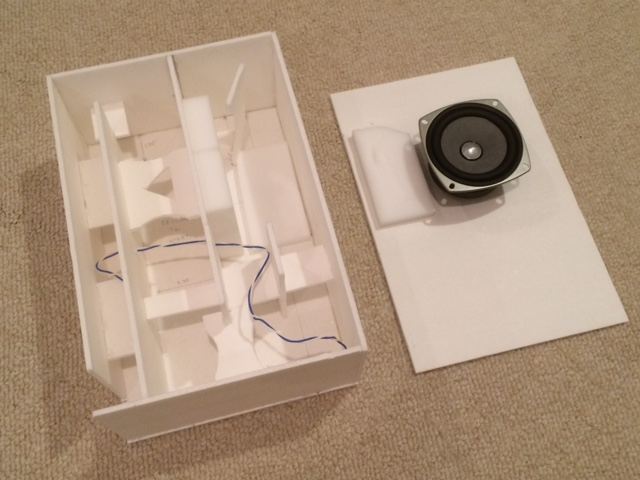
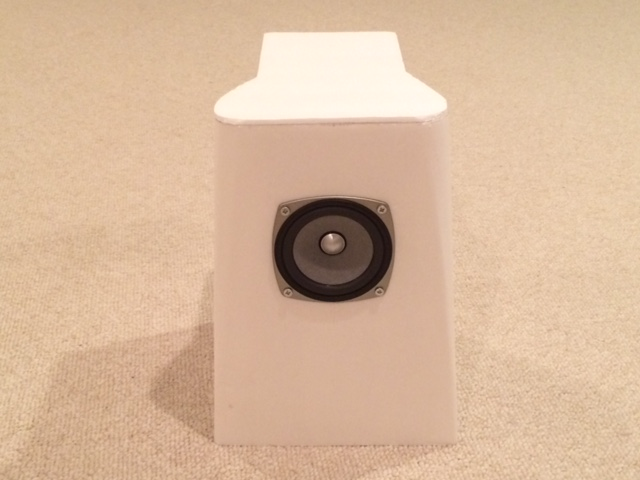
Check out the video of the snappy bass (change extension from .asc to .mov to watch):
http://www.diyaudio.com/forums/atta...ookshelf-ff105wk-tl-vent-action-movie.mov.asc
TL : a mess, there is a load, too much long time to load it like an organ pipe, hard to tune both the cabinet and the internal damping, and a bump near the low iirc !
I just built a small tapered TL for the FF105WK and it has some nice snappy bass. I am not sure I sense the long delay to load it. More info here:
http://www.diyaudio.com/forums/full-range/279546-ff105wk-tl-desktop-bookshelf.html


Check out the video of the snappy bass (change extension from .asc to .mov to watch):
http://www.diyaudio.com/forums/atta...ookshelf-ff105wk-tl-vent-action-movie.mov.asc
Last edited:
Hi X, have you investigated deeper whether it's the small phase distortion or the same absolute polarity between drivers, that contribute more to the snappy sound?
I recently swapped the polarity of my comp drivers (or mids in below measurements). Now they step in the same direction than the mids (and every other driver as well). Phase distortion increased from 180deg to 360deg (compared to minimum phase plot) and the measured excess group delay increased, yet the sound is snappier with drums and other percussions instruments, piano. Dynamics seem more dangerous, waking up the half-sleeping listener.
I believe the snappiness comes from the fact that same direction stepping drivers can create bigger "one direction" pressure changes (rarefaction/compression). The wavefront of given transient is either compression or rarefaction, not some mess of both in tightly spaced manner like in "regular" multiway speaker. Tactile sensors and ears detect this as more explosive sounds (even though there could be more phase distortion like in my case).
These are 0deg near field measurements what exaggerates the midwoofer's output.
Phase of original setting:

Phase of the new setting:

The old setting has one phase wrap, the new setting has two (although the lower one is almost out of the Synergy horn's pass band):

Step of the original setting:

Step of the new setting:

Excess group delay of the old setting:

Excess group delay of the new setting:

Basic GD plots of the settings:

I recently swapped the polarity of my comp drivers (or mids in below measurements). Now they step in the same direction than the mids (and every other driver as well). Phase distortion increased from 180deg to 360deg (compared to minimum phase plot) and the measured excess group delay increased, yet the sound is snappier with drums and other percussions instruments, piano. Dynamics seem more dangerous, waking up the half-sleeping listener.
I believe the snappiness comes from the fact that same direction stepping drivers can create bigger "one direction" pressure changes (rarefaction/compression). The wavefront of given transient is either compression or rarefaction, not some mess of both in tightly spaced manner like in "regular" multiway speaker. Tactile sensors and ears detect this as more explosive sounds (even though there could be more phase distortion like in my case).
These are 0deg near field measurements what exaggerates the midwoofer's output.
Phase of original setting:

Phase of the new setting:

The old setting has one phase wrap, the new setting has two (although the lower one is almost out of the Synergy horn's pass band):

Step of the original setting:

Step of the new setting:

Excess group delay of the old setting:

Excess group delay of the new setting:

Basic GD plots of the settings:

Last edited:
Legis,
Allow me to guess that your new setting show the real phase shift that your acoustic slopes is responsible. The old setting showed less phase turn because you probably used reverse polarity to get a certain acoustic center fire timing offset, that value in real time must be what math will reveal 180º phaseshift at acoustic XO point will be. The new setting at SR plot think show HF need some delay physical or electric relative to LF to get first step rise up to 100%. If remember correct you turned to run passive + acoustic XO, so a simple electric delay or new XO slopes is not easy to do, but guess if you run DSP active setup Harsh XO slopes BW4(LR4) for LF and BES2 plus a delay would be easy to try to get phase as xrk971 show at post 1.
Allow me to guess that your new setting show the real phase shift that your acoustic slopes is responsible. The old setting showed less phase turn because you probably used reverse polarity to get a certain acoustic center fire timing offset, that value in real time must be what math will reveal 180º phaseshift at acoustic XO point will be. The new setting at SR plot think show HF need some delay physical or electric relative to LF to get first step rise up to 100%. If remember correct you turned to run passive + acoustic XO, so a simple electric delay or new XO slopes is not easy to do, but guess if you run DSP active setup Harsh XO slopes BW4(LR4) for LF and BES2 plus a delay would be easy to try to get phase as xrk971 show at post 1.
The new setting at SR plot think show HF need some delay physical or electric relative to LF to get first step rise up to 100%. If remember correct you turned to run passive + acoustic XO, so a simple electric delay or new XO slopes is not easy to do, but guess if you run DSP active setup Harsh XO slopes BW4(LR4) for LF and BES2 plus a delay would be easy to try to get phase as xrk971 show at post 1.
Hi BYRTT, the height of the step depends also on the relative level of the drivers. Those near field measurements add more to the midwoofers output so they dominate also in the step response.
Both step to ~100% when measured further away, but still the comp driver should be delayed somewhat, it propably should step more in the middle or at the end of the mids' step:
An externally hosted image should be here but it was not working when we last tested it.
Last edited:
- Home
- Loudspeakers
- Multi-Way
- S. Harsch XO
